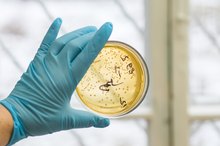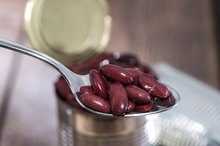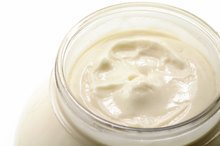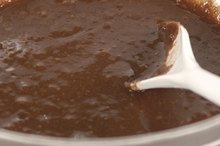What does fact checked mean?
At Healthfully, we strive to deliver objective content that is accurate and up-to-date. Our team periodically reviews articles in order to ensure content quality. The sources cited below consist of evidence from peer-reviewed journals, prominent medical organizations, academic associations, and government data.
The information contained on this site is for informational purposes only, and should not be used as a substitute for the advice of a professional health care provider. Please check with the appropriate physician regarding health questions and concerns. Although we strive to deliver accurate and up-to-date information, no guarantee to that effect is made.
Mayonnaise & Food Poisoning
Food poisoning is defined by the National Library of Medicine and the National Institutes of Health as a condition caused by ingesting bacteria, parasites or toxins 1. The majority of food poisoning cases are associated with common bacteria such as E. coli and Staphylococcus 1. Many foods are associated with food poisoning, but mayonnaise is one of the most common 1.
If you are experiencing serious medical symptoms, seek emergency treatment immediately.
Food Poisoning
Food poisoning is a condition that is often left undiagnosed due to the similarity of its symptoms to an upset stomach 1. Nausea, vomiting, diarrhea and abdominal cramping are all symptoms of food poisoning 1. Symptoms can occur within hours of consuming the contaminated food or could take days to show up.
Mayonnaise
Four Conditions for Bacterial Growth
Learn More
Mayonnaise is commonly blamed for cases of food poisoning, but a New York Times article places the blame elsewhere 1. According to the article, commercial brands of mayonnaise are very acidic due to the abundance of vinegar and other ingredients. A benefit of the high acidity is spoilage prevention. The article attributes the food-borne illnesses linked with mayonnaise to other factors. Other foods prone to contamination such as chicken or ham top the list. Mixing these foods with mayonnaise can increase the incidence of mayonnaise being linked to food-borne illness. The article also suggests that improper storage and making homemade mayonnaise can increase the likelihood of food poisoning 1.
Risk Factors
Everyone is at risk for contracting a food-borne illness. There are several factors that influence whether or not an individual is at an increased risk of contracting food poisoning 12. According to the Mayo Clinic older adults, pregnant women, infants and young children, and individuals with chronic diseases are more at risk 2. All of these conditions may weaken the immune system thus, putting the individual at a higher risk.
Treatment
Botulism Risk of Canned Beans
Learn More
Food poisoning generally resolves itself within a few days 1. Food poisoning can vary in severity and require different forms of treatment 1. Generally speaking, the main focus of treatment is to ease discomfort and avoid dehydration. Fluid replacement is extremely important during treatment. A solution with added electrolytes may be necessary for children due to the amount lost through vomiting and diarrhea. Medical attention may be necessary if fluids cannot be ingested. In such instances, an IV can provide essential nutrients until the temporary illness passes.
- Food poisoning generally resolves itself within a few days 1.
- A solution with added electrolytes may be necessary for children due to the amount lost through vomiting and diarrhea.
Prevention/Solution
With a few simple precautions, preventing food poisoning can be easy 1. The Association for Dressings and Sauces offers simple tips that can ensure food safety. Cleanliness is of utmost importance when dealing with foods. Any surface that comes in contact with foods should be sanitized and cleaned regularly, including hands, utensils and cutting boards. Special care should be taken when using raw meats to wash hands and tools used before and after with both soap and water. Hand sanitizers are convenient for travel and picnics when soap and water may not be available. Another important prevention measure involved preparation and storage of foods. Foods should be cooked to the proper temperature to eliminate any bacteria that might be present. Storing foods at appropriate temperatures is also very important. Hot foods should be kept hot and cold foods should be kept in coolers and on ice, especially when traveling.
- With a few simple precautions, preventing food poisoning can be easy 1.
- Hand sanitizers are convenient for travel and picnics when soap and water may not be available.
Related Articles
References
- NLM and NIH: Food poisoning
- The Mayo Clinic: Food poisoning: Risk factors
- Centers for Disease Control and Prevention. (2019). Foodborne Illnesses and Germs.
- Cdc.gov. x. Burden of Foodborne Illness: Findings | Estimates of Foodborne Illness | CDC. Published 2018
- Cdc.gov.. Burden of Foodborne Illness: Findings | Estimates of Foodborne Illness | CDC. Published April 2019.
- Papaconstantinou HT, Thomas JS. Bacterial colitis. Clin Colon Rectal Surg. 2007;20(1):18–27. doi:10.1055/s-2007-970196
- Sobel J. Botulism. Clin Infect Dis. 2005;41(8):1167-73. doi:10.1086/444507
- Food Poisoning Symptoms. Centers for Disease Control and Prevention. Published October 11, 2019.
- Bintsis T. Foodborne pathogens. AIMS Microbiol. 2017;3(3):529–563. Published 2017 Jun 29. doi:10.3934/microbiol.2017.3.529
- Chris A. Norwalk-like viruses: when the runs can slow you down [published correction appears in CMAJ. 2003 Feb 18;168(4):400]. CMAJ. 2003;168(1):64–65. PMID: 12515788
- Pinchuk IV, Beswick EJ, Reyes VE. Staphylococcal enterotoxins. Toxins (Basel). 2010;2(8):2177–2197. doi:10.3390/toxins2082177
- Humphries RM, Linscott AJ. Laboratory diagnosis of bacterial gastroenteritis. Clin Microbiol Rev. 2015;28(1):3–31. doi:10.1128/CMR.00073-14
- Dekker JP, Frank KM. Salmonella, Shigella, and yersinia. Clin Lab Med. 2015;35(2):225–246. doi:10.1016/j.cll.2015.02.002
- Arendt S, Rajagopal L, Strohbehn C, Stokes N, Meyer J, Mandernach S. Reporting of foodborne illness by U.S. consumers and healthcare professionals. Int J Environ Res Public Health. 2013;10(8):3684–3714. Published 2013 Aug 19. doi:10.3390/ijerph10083684
- FDA. Are You Storing Food Safely? U.S. Food and Drug Administration. Published June 4, 2016.
- Public Affairs. Recalls and Outbreaks. FoodSafety.gov. Published November 21, 2019.
- Lund BM. Microbiological Food Safety for Vulnerable People. Int J Environ Res Public Health. 2015;12(8):10117–10132. Published 2015 Aug 21. doi:10.3390/ijerph120810117
- Smith JK, Burns S, Cunningham S, Freeman J, McLellan A, McWilliam K. The hazards of honey: infantile botulism. BMJ Case Rep. 2010;2010:bcr0520103038. Published 2010 Sep 29. doi:10.1136/bcr.05.2010.3038
- Krugman's Infectious Diseases of Children, 11th edition. Philadelphia, PA: 2004.
Writer Bio
Amanda Davis began writing in 2010 with work published on various websites. Davis is a dietetic technician, registered, personal trainer and fitness instructor. She has experience working with a variety of ages, fitness levels and medical conditions. She holds a dual Bachelor of Science in exercise science and nutrition from Appalachian State University and is working toward her master's degree in public health. Davis will be a registry eligible dietitian in May 2015.









